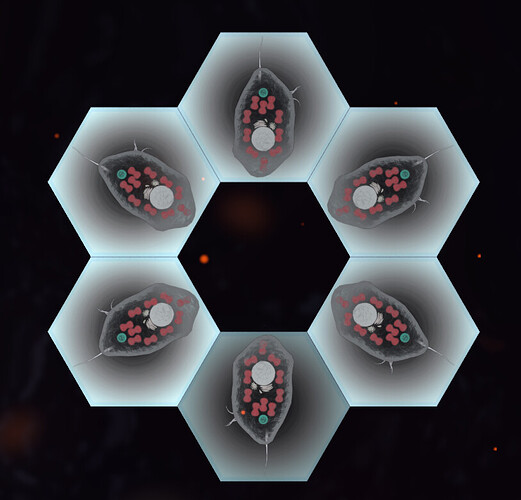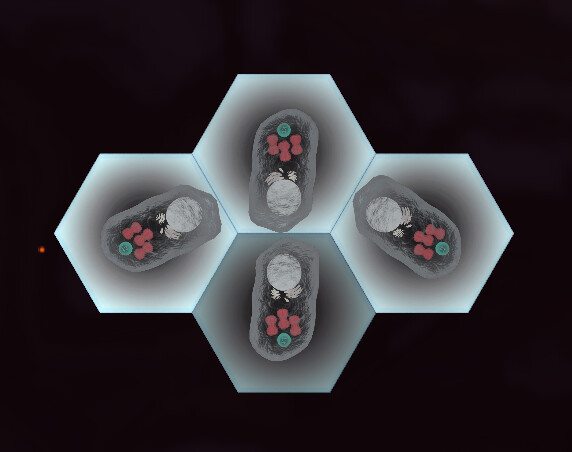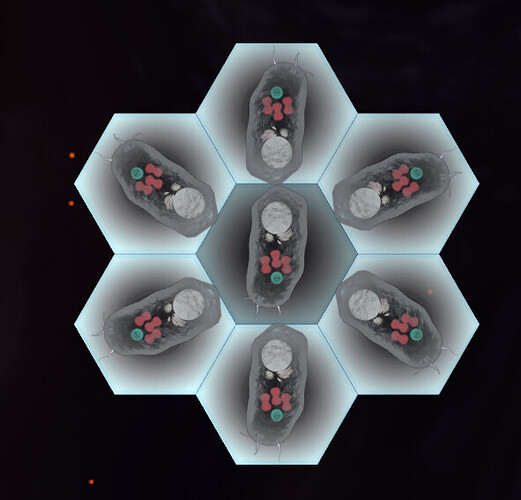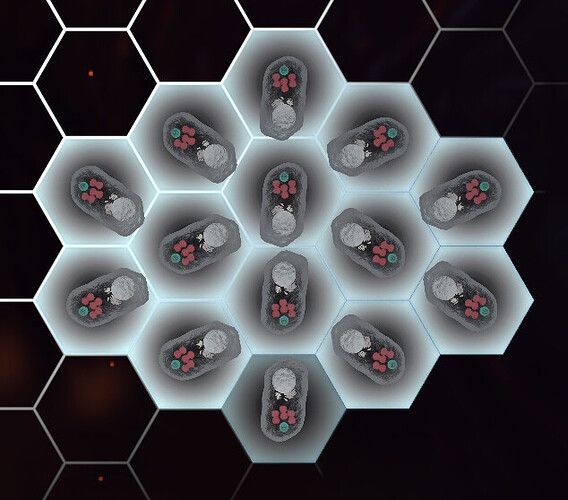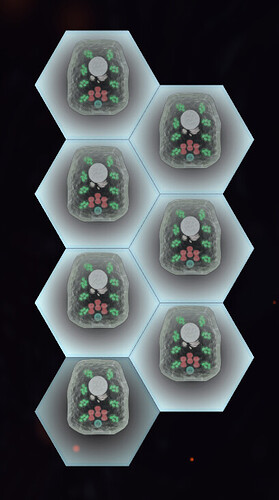I think it’s a good idea to have some sort of baseline discussion related to the Multicellular Stage before we dive headfirst into it after 1.0. I want to note that there are many other threads related to the Multicellular Stage:
These are older, and were also started before we had the dedicated Multicellular-Macroscopic switch instead of the legacy Early/Late Multicellular dynamic. They also generally started with the assumption of a smooth transition between the microscopic and macroscopic stages, and have many ideas scattered all over the place, so I think it’s fair to start a new, centralized thread in wake of the upcoming completion of the Microbe Stage.
The Premise
You’ve weathered the climate instability, found a viable base for your metabolism, and fought off other simple lifeforms. Successfully passing the Microbe Stage shows that you have proved your ability to succeed in this young, alien world, through all its swings, hitches, and competition. Your planet has reached some sort of equilibrium, and those wild swings have calmed.
But now, you must contend with another threat - multicellular lifeforms. Weird lifeforms, with bizarre shapes and eccentric abilities have shown up, proving to offer completely different capabilities. They grow back portions of themselves, spray out immense barrages of toxin warfare, have spikes all over them, and all-in-all, are difficult to handle.
Fending off competition isn’t so simple anymore. In this strange new world with organisms armed to the teeth, how do you keep yourself alive?
Progression, Differences, and Themes Between the Microbe and Multicellular Stages
The challenge of the Microbe Stage is keeping your organism away from extinction in the face of a rapidly-shifting, young, and immature planet. With oxygenation, glaciation, and the shifting of important compounds, players are generally trying to stay afloat in the face of some sort of volatility. They also face off with other organisms for the first time, who are also trying to establish a niche.
In the Multicellular Stage, the emphasis shifts from surviving through massive planetary shifts, to surviving against intense competition from other lifeforms. You will naturally have settled on the niche that keeps you alive, and will have found that your planet is generally much more established now, with oxygen stable, resource diffusion generally rounding out, and some sort of defense against early lifeforms.
However, facing off with multicellular organisms offers different challenges, for two fundamental reasons in game right now without any need for dedicated Multicellular mechanics:
Many cells will be somewhat similar in size as you, so engulfment is much less powerful. In most cases, you can’t just button-click your competition away.
Killing one cell doesn’t mean you’ve dealt with the threat - there are other cells you must kill, deter, or evade.
So combat is much different now - instead of combatting a single cell, you must combat multiple. And instead of keeping a single cell alive, you need to take care of multiple.
Think of the Microbe Stage as sailing a raft during a storm with pirates - also in rafts - around you. Your primary focus is making sure your raft doesn’t sink; sure, you don’t want to bump into a pirate, but you’re not sure if you’ll even be floating by the time you bump into one, and they’re worried about sinking too.
The Multicellular Stage is what happens after the storm calms down. The water is tranquil, so you’re not worried about your boat capsizing; however, no one else is either. And they’re hungry for your cargo.
Analogy aside - we should be cognizant of this new baseline when designing the Multicellular Stage.
Multicellular Stage Expectations
Embrace the Goofiness
Let’s be real - the Multicellular Stage is probably going to be really, really weird. Just as the microscopic patch map abstractly represents an early planet to a microscopic organism, the Multicellular Stage will be a pretty abstract representation of a stretch of evolutionary time that we don’t know too much about.
Beyond the theory however, we’ll be transforming a stage that for approximately ten concrete years of development has been built around a unicellular experience into a stage where you place multiple cells and figure things out. There are bound to be slightly overpowered strategies, physically outlandish interactions, and pretty funny moments. There’s going to be giant blobs bumping into each other, piluses colliding awkwardly, toxins bombarding the screen, chunks of multicellular organisms popping with organelles and goop scattering everywhere, and general carnage.
Instead of minimizing that and running in two directions with our game design, I think we embrace it. We think of the Multicellular Stage as the player pushing our game mechanics to their creative limits, we create new mechanics to encourage this creativity and reign in undesired behavior, and we make sure nothing crashes, breaks, or causes a physics implosion. We treat this stage like the developers of Besieged, Robocraft, or KSP treat their games - we give them tools in an arms race that constantly feels unbalanced, and challenge our players to make sense of things.
Making a Monster
Get that Microbe risk-adverse crap out of here, you’re making a monster! In the Microbe Stage, controlling one organism forces us to really make it so that the player is wary of putting their system out of balance. Fine-tuning your metabolism, ensuring that energy costs are maintained, and making sure you won’t starve the next generation dominate your strategy.
In the Multicellular Stage, you’ve proven you’re up for that task; now, with that established, make your stats pop!
To reflect the more advanced capabilities multicellular organisms have via cell differentiation, Multicellular Stage mechanics will focus on optimization. We want it so that players can make cells that generate tons of toxins, generate tons of speed, resist a lot of damage, generate a huge energy surplus, etc. Introduced mechanics will focus on dynamic ways to boost stats in the editor, cognizant of the fact that you are controlling a general body plan over a unicellular organism.
Of course, we must be wary that players completely avert the possibility of being killed, starving, or otherwise are able to become so bloated that they are unchallenged. We should think of a good constraint that limits unchecked progression, and of course, tradeoffs are wonderful tools. But, all things being equal, the Multicellular Stage will demonstrate the capacity for more extreme stats than the Microbe Stage.
Gimme Gimme Gimme
In the Microbe Stage, player objectives should generally center ensuring that you are able to adapt to whatever swing is coming in your direction, whether that’s an environmental event, a change in the environment, a dying out of your preferred prey item, or the introduction of a new ability. Those dynamics should be present in the Multicellular Stage of course - they are universal concerns in evolution.
But another objective should also appear, reflecting the greater emphasis on sandbox principles in the Multicellular Stage: the desire for more. More speed, more energy, more damage, more resilience, etc. Players should be constantly pushing the envelope with their build, and should generally have a greater appetite for abilities and capabilities than they do in the Microbe Stage.
A Microscopic Crescendo
I’m sure I’ve said this multiple times, but it’s still valid now: the Multicellular Stage is a sending off of Microbe Stage mechanics. As such, an aspect of this crescendo is providing some sort of boosted abilities. In our concept of Multicellular Stage, there should be room for additional abilities.
General Roadmap
This isn’t a road map that defines Thrive’s scope, like hhyyrylainen’s Microbe Stage roadmap - we’re not there yet. But this is generally what I expect development on the Multicellular Stage to look like in the creation of a healthy stage.
- Initial Framework & Brainstorming - I anticipate implementation here to be somewhat limited, primarily focused on things like refining the binding agent progression, defining how players unlock multicellularity, and providing a constraint on progression for adding more cells. Also fundamental things like figuring out how metabolism and compound-sharing will work, as well as how stats are generally calculated.
- Centering Key Mechanics - We start figuring out the direction we want to take here, what works and doesn’t work, and iron out core mechanics. Then, we ensure general balancing polish. This is around where we can make a roadmap discussing scope.
- Synergizing Microbe and Multicellular Stage - It would be wise to briefly tweak Microbe Stage pacing and progression to reflect the new dimensions of gameplay introduced by the Multicellular Stage. Emphasizing swings in the Microbe Stage, and stability and competition in the Multicellular Stage, will result in a well-paced Microscopic portion of Thrive’s gameplay. This gives us a great base game as we move onto Macroscopic development.
I would like to note that the last bullet point does not justify big balancing swings for current Microbe Stage development. Making the Microbe Stage more volatile for the sake of a stage not currently implemented hampers our current game (the game entirely being the Microbe Stage). I do otherwise advocate for more volatility in the Microbe Stage, but currently, for the sake of improving the stage itself, not the future Multicellular Stage.
Concept Proposals
Body Plan Statistics Revamp
We’ll have to treat statistics differently to emphasize different capabilities offered by becoming Multicellular. Multicellular organism stat mechanics will have to emphasize the capability of energy sharing between cells in a way that reflects an emphasis on holistic performance overcoming individual shortcomings on cells.
Holistic Energy Balance: Instead of a cell’s individual balance determining whether or not it has enough ATP to survive, in the Multicellular Stage, the balance of the body plan as a whole is much more important. As long as you have the machinery in your energy-generating cells to support it, a cell with a negative balance, like one overtly dedicated towards flagellum, toxins, or more, can persist.
Multicellular organisms allow the budgeting of energy in a way that allows for differentiated mechanics. Cells that would otherwise starve or be defenseless as independent organisms can be incredibly important to the performance of a multicellular organism. Implementing this holistic energy balance mechanic would proximate this effect, leading to greater potential for specialization, experimentation, and build diversity.
Beyond that, looking at stats based on the holistic shape of your multicellular organism is a good idea. Things like surface area compared to volume, a streamline measure, mass, etc. affecting certain stats.
Adjacency Bonus
Implementing some sort of mechanic to provide a parametric layer of depth when it comes to cell layout would be great. There are implicit dimensions in Thrive already which already kind of encourage this - mobility cells near the back, engulfing cells near the front, durable cells on the outside, etc. - but many internal parts are omitted.
An adjacency bonus mechanic, where certain stats are boosted depending on how cells are linked together, would be a solid baseline concept to look at. For cells that are different types, certain parts provide different stat boosts dynamically - for example, vacuoles next to a toxin part provides a greater boost to toxin storage, mitochondria next to a flagella/cilia provide greater speed/mobility, cilia next to lysosomes provide greater digestion stats, etc. The more of a specific part there is in a cell, the more that adjacency bonus increases, encouraging specialization.
We would have to carefully map these relationships out in order not to overwhelm the player, or to not have a barrage of numbers even if players don’t intentionally build for them in mind. But such a mechanic would be great for replayability, giving a new dimension of building your perfect organism to more experienced players.
Combat Abilities
It would be great to introduce new and unique combat abilities to the Multicellular Stage, but there are a great deal of combat mechanics we can implement to juice up the arms race in this stage.
We can make it so that if your initial cell dies, your entire colony dies. Keeping this core cell alive is of the utmost importance. This provides a consistent strategy in combat, and gives some depth to combating other species - figuring out your competition’s “heart” can be an interesting dynamic of evolution. Orienting your tools to get to this vital cell, and orienting your own body plan to protect your vital cell would also add another layer of decisionmaking in the editor.
Life Cycles?
One thing I will draw attention to however is the fact that there is an inherent representation of life cycles in the Multicellular Stage; even in the prototype, your organism will drastically change throughout its life as it grows more cells.
This is probably the easiest stage in Thrive to implement the frequently-requested phenomena of “life phases”, so it might be worth considering giving players options as to how individual cells can change throughout time as we conceptualize this stage. I think at the very least, making it so that your initial, starting cell (your core cell, perhaps) has some ability to lose parts that are more important at the early stages of life, like flagellum/cilia, as its role in your organism’s body changes.
Concluding Questions
Finally, I think it would be useful to make sure we are all on the same page about the general bounds of the Multicellular Stage. Again, this stage has gone through scope creeps and shrinkage, so it can be a bit confusing discussing it. With the time jump between the Multicellular and Macroscopic stages, we should firmly state what we intent to represent in this stage, and what is beyond our ambition.
I have some starting questions…
- Do we think we have room to represent 2D organisms which almost seem to be acquiring a shape where cells start to blend together? We obviously can’t make the player place down hundreds of cells, but is there a way to simplify a representation of that many cells in this 2D world? And is that something we desire? I personally can imagine something like that is feasible if we represent cells with general metaballs, but I think that would introduce very specialized mechanics that would only be used for a very short stretch of time in a Thrive playthrough.
- How many cells do we expect players to place down at the most? The more the merrier, to a certain extent; too many cells will tank performance, and will be pretty unruly to manage. Progression to the next stage should work in a way that is more than just “get X number of cells in your body”, so I’m not saying we should place a hard cap on it; but we can introduce mechanics to make scaling up inefficiently harder, like a binding cost that increases non-linearly the most cells you have on you. Do we make it so that players generally work with around 10 cells at the “climax” of the Multicellular Stage? More? Less?
- How long will an average life take? There’s an fresh spawn phase, a growing phase, and a fully grown phase we want to include. We should probably make sure that the player gets to experience their fully grown organism for around 2 minutes, plus or minus some time depending on how good at gathering ammonia or phosphate they are. But we also want to include those other parts of a simple Multicellular organism’s life. Perhaps around 3 minutes for the smallest/most simple multicellular organisms, to around 5 minutes for the larger ones?
- How long should the Multicellular Stage take? In my mind, the microscopic stages of Thrive should take an average of four hours, plus or minus an hour if you want to rush through/play optimally or experiment in/struggle a bit more. Should the Multicellular be shorter than the Microbe Stage, or longer? We don’t really have to set forth with crafting this stage with an exact time in mind, as we can balance growth and metabolic rates down the road if we get feedback about pacing; it’s just good to keep in mind a rough estimate as we develop.
